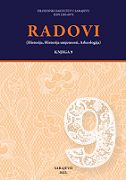Neobjavljeni arheološki materijal sa lokaliteta brda Stražbenica u naselju Bukovača kod Bosanskog Petrovca
Unpublished archaeological materials from the site of Stražbenica hill in Bukovača near Bosanski Petrovac
Author(s): Adnan BusuladžićSubject(s): Archaeology, Museology & Heritage Studies, Architecture, Visual Arts, Middle Ages, Cultural Anthropology / Ethnology, Prehistory
Published by: Filozofski fakultet Univerziteta u Sarajevu
Keywords: Stražbenica fort; Bosanski Petrovac; hilltop forts; Roman fibulae; Roman coins; military equipment; ceramics; horseshoes;
Summary/Abstract: The fort located on Stražbenica hill in the village of Bukovača in Bosanski Petrovac completes the picture of the Roman presence in western Bosnia. It has long been known as potentially very promising for systematic archaeological investigations, as suggested by the quantity of chance finds at the site, and the visible remains of architectural structures. Thus far unpublished finds also suggest that the site is worth studying, and that it could very likely yield not only mainly Roman material, but also remains of earlier periods. Pottery found there points to cultural strata that can probably be dated to the metal ages, but also to the early mediaeval period (Plate 2, figs, 3 and 5). Stronge evidence of the Roman presence from as early as the 2nd century is provided by Probus coins (Plate 1, figs. 1 and 2), and strikingly moulded fibulae (Plate 2, fig. 2), which were made in particular at Siscia, to which Stražbenica is relatively close. Monetary circulation is also evidenced by a very fine silver Antoninus Pius imperial coin (Plate 1, figs. 3 and 4). A milestone that has stood in situ in Stražbenica for centuries suggests that this was a much frequented route (Plate 1, fig. 5). Furthermore, finds of pieces of horseshoe provide evidence that the route was used by pack animals, mainly horses, to carry both people and goods, particularly in late Antiquity (Plate 2, fig. 1). A crossbow fibula (Plate 1, fig. 6) probably also dates from that period, and, along with a prismatic arrow (Plate 2, fig. 4), attests to some form of life in the unsettled, uncertain times of late Antiquity. Analysis of the chance finds from the site points to a human presence there from the metal ages to late Antiquity and into the early mediaeval period. The fort at Stražbenica hill in the village of Bukovača in Bosanski Petrovac is just one of a series of hillfort-type settlements dating from pre-Roman times and remaining in use for centuries thereafter. Pre-Roman castella and oppida such as Kolunić, Gradić at Žuta glavica, Kadinjač, and the settlements in Krnjeuša and the village of Bare provide further evidence of this.
Journal: Radovi: Historija, historija umjetnosti, arheologija
- Issue Year: 9/2022
- Issue No: 1
- Page Range: 13-30
- Page Count: 18
- Language: Bosnian

